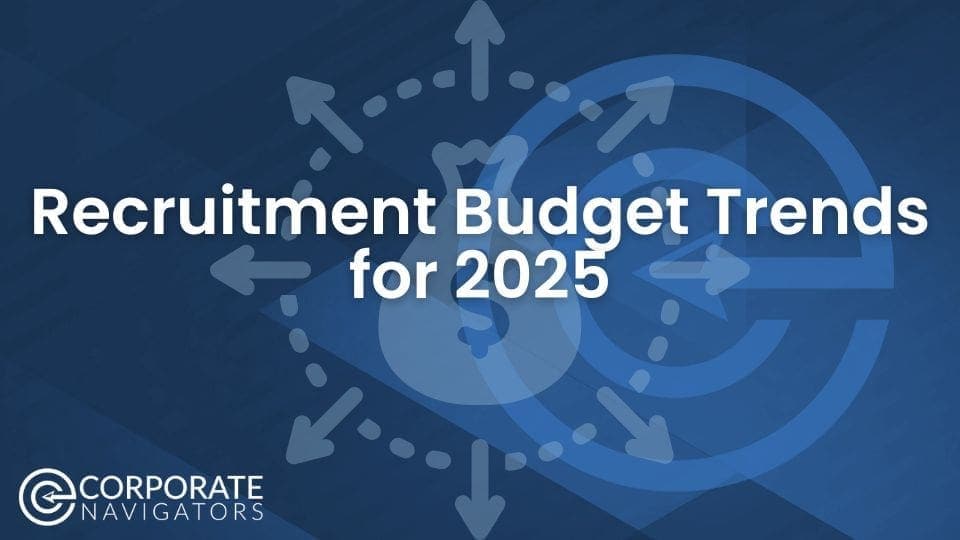
Table of Contents
Recruitment Budget Trends for 2025
To source quality candidates, many companies invest in the process with in-house recruiting teams or outsource the search to recruiting research firms. They typically have a budget for sourcing, identifying, and onboarding new talent. This is just one of the many metrics that can assist you this year as you make plans for your business. (For more reference, check out our other guides on time to fill, turnover rates, cost per hire, and other useful recruiting statistics.)
Typical 2025 Recruitment Budget by Category
From verified data such as SHRM’s Talent Acquisition Benchmarking Report, we broke down 2025’s typical recruiting budget into seven categories:
Technology and Tools: 35%. +10% from 2024.
Branding and Marketing: 17%. +5% from 2024.
Diversity, Equity, and Inclusion: 12%. +5% from 2024.
Talent Acquisition Teams: 25%. -5% from 2024.
Candidate Experience: 8%. +2% from 2024.
Sustainability and Ethical Recruitment: 6%. +2% from 2024.
Remote and Hybrid Work Models: 10%. -6% from 2024.

What’s behind the increases and decreases in budget allocations?
What’s behind the increases and decreases in budget allocations? Overall, more companies are focusing on branding and creating a more streamlined recruiting experience through technology and tools.
Technology and Tools – 35%.
This includes emerging recruitment technology like Artificial Intelligence (AI), chatbots, screening tools, predictive analytics, automated tools, data analytics, ATS (applicant tracking systems), and digital recruitment platforms. An increase from 25% in 2024.
Branding and Marketing – 17%.
In 2025 there will be a heightened interest in boosting brand image to attract talent. This includes all employer branding and recruitment marketing. This is an increase of around 12%, the average for 2024.
Diversity, Equity, and Inclusion – 12%.
Ensuring there is a more diverse candidate pipeline continues to be a priority into 2025. In fact, spend in this area is to increase from a 7% average in 2024. This is due to the greater emphasis on building a diverse and functional workforce for maximum productivity and innovation.
Talent Acquisition Teams – 25%.
Human expertise is still critical in the candidate search, in spite of the rise of AI tools. This includes salaries for recruiters, training, and professional development. Decreased from 30% due to more AI usage.
Candidate Experience – 8%.
A faster hiring process, enhanced interview experiences, and better communication. It also ensures that companies don’t lose good talent to another company through inefficient wait times and slow or no follow-ups. A projected increase from 6% in 2024.
Remote and Hybrid Work – 10%.
Pertains to virtual hiring platforms, tools for remote team integration, and global talent acquisition strategies. Since these provisions are more established, this percentage is a decrease from 16% in 2024.
Sustainability and Ethical Practices – 6%.
In 2025, fair labor practices, transparency in recruitment, and reducing the environmental impact of hiring processes. Spend in this area is expected to grow from last year’s average of 4%.

Average Corporate Budgets for Recruitment
According to the most recent NACE Recruiting Benchmarks Report, the average corporate budget for recruitment is around $830,000 per year.
However, we’re better off breaking down this average by company size for better accuracy:
- 1,000 to 2,500 employees = average recruiting budget of $143,300.
- 50,000+ employees= average recruiting budget of $2.6 million.

Over the past few years, internal staffing of recruitment operations teams have steadily declined:
- 2019: 20.1 Employees
- 2021: 17.9 Employees
- 2022: 14.9 Employees
- 2023: 13.5 Employees
As the number of recruitment operations staff has steadily decreased, the average number of recruiters within these teams have also followed suit.
- 2021: 8.5 Recruiters
- 2022: 9 Recruiters
- 2023: 7.2 Recruiters
Average Recruitment Budget Trends for 2025
The evolving landscape of recruitment budgets for 2025 reflects a strategic shift towards embracing advanced technologies and refining recruitment processes. Companies are channeling more resources into technology and branding to enhance their appeal and efficiency in attracting qualified candidates. Investments in diversity, equity, holistic workplace environments, and inclusion continue to gain momentum, highlighting a commitment to building more inclusive workforces.
While the allocation for talent acquisition teams has seen a slight decrease due to the rise of AI tools, the focus on candidate experience and ethical practices remains strong, ensuring a holistic approach to recruitment.
The slight reduction in budget for remote and hybrid work models indicates a maturation of these strategies. Overall, the trends suggest that organizations are not only investing in the tools and techniques to streamline their hiring processes but also placing greater emphasis on creating a compelling candidate experience and fostering an inclusive and ethical recruitment environment.



